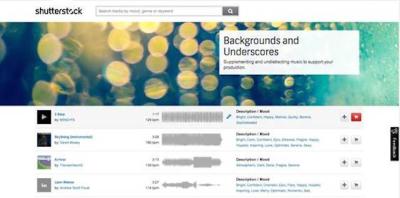If you’ve ever searched for the perfect image online, you know how tempting it is to find a high-quality picture that fits your project. Shutterstock is a fantastic resource for stunning images, but their watermarks can make it tricky to see what a photo truly looks like before purchasing. Luckily, there are legitimate ways to access Shutterstock images without watermarks for free, whether for inspiration, testing, or preliminary design work. In this post, we’ll explore how to view these images legally and what you need to know about
Understanding Shutterstock’s Licensing and Watermark Policy
Shutterstock operates on a licensing model that gives users the right to use images legally after purchase. When you browse their library, you’ll notice that most images are displayed with a watermark—these are low-resolution previews designed to prevent unauthorized use. The watermarked versions are meant for preview purposes only; they aren’t meant for commercial or public use.
Here’s what you should know about Shutterstock’s licensing and watermarks:
- Watermarks are for preview only: They help protect photographers’ rights by showing a sample image without giving away the full version.
- Downloading watermarked images is free: You can view them without cost, but they can’t be used in final projects.
- Purchasing licenses removes watermarks: To use an image legally, you’ll need to buy a license, which grants you full rights and removes the watermark.
- Free images are rare: Shutterstock does occasionally offer free images or trials, but these are typically limited in number and scope.
- Respect copyright laws: Using images without proper licensing can lead to legal issues. Always ensure you’re compliant with Shutterstock’s policies.
Understanding this policy helps you navigate Shutterstock‘s offerings responsibly. If you’re just looking for images to get ideas or for non-commercial use, previewing watermarked images is completely acceptable. However, for anything beyond that, you’ll need to purchase or explore legitimate free alternatives. Next, let’s look at some ways you can access images without watermarks legally and ethically, ensuring you stay within the bounds of copyright law while still getting the visuals you need.
Legal Ways to Use Free Shutterstock Images Without Watermarks
When it comes to using images from Shutterstock, the most important thing is to make sure you’re doing so legally and ethically. While Shutterstock is a paid platform, there are legitimate ways to access their images without watermarks at no cost, but they come with some conditions. Let’s explore how you can do this safely and legally.
First up, always look for images that are explicitly labeled as free. Shutterstock occasionally offers free images, especially during special promotions or campaigns. These are usually available for download without watermarks, but often with some restrictions. Make sure to check the licensing terms attached to these images — some might be free for personal use but require a license for commercial projects.
Another way is to sign up for Shutterstock’s free trial. They often offer a limited period during which you can download a set number of images without watermarks. During this trial period, the images are fully licensed, meaning you can use them legally in your projects. Just remember to cancel before the trial ends if you don’t wish to continue with a paid subscription.
Additionally, Shutterstock sometimes provides free images through their partner programs or promotional campaigns. These images are typically available through special links or via their social media channels. Always verify the source and the licensing details before using these images to ensure you’re respecting copyright laws.
Lastly, if you’re a student or educator, check if your institution has access to Shutterstock’s educational licensing. Some educational programs provide free or discounted access to stock images, which you can use legally without watermarks for your assignments or projects.
In summary, the key to using Shutterstock images legally and without watermarks is to:
- Look for official free resources on Shutterstock.
- Utilize free trial periods responsibly.
- Follow promotional campaigns and partner links carefully.
- Check for educational licensing options.
Always respect copyright laws and licensing agreements. Using images ethically not only keeps you out of legal trouble but also supports creators and platforms that produce quality content!
Utilizing Free Stock Image Websites as Alternatives
If you’re looking for high-quality images without watermark hassles and licensing worries, the best bet is to explore free stock image websites. There are many reputable platforms offering a vast array of images that are free for personal and commercial use. Let’s walk through some of the top options and how to make the most of them.
Some of the most popular free stock image websites include:
| Website | Key Features |
|---|---|
| Unsplash | High-resolution photos from talented photographers; no attribution required but appreciated; vast categories. |
| Pexels | Beautiful, free stock images and videos; very easy to search; licenses allow for commercial use without attribution. |
| Pixabay | Over 1.7 million images, videos, and music; free for commercial and personal use; no attribution needed. |
| Freepik | Offers vectors, PSDs, and photos; some resources are free, but check license details for each. |
| Stocksnap.io | New images added weekly; simple licensing; no attribution necessary. |
Using these sites is straightforward. Just search for your keywords, browse through the results, and download images in the resolution you need. Most of these platforms also provide filters for orientation, color, and even specific categories, making it easier to find the perfect image quickly.
Here are some tips for getting the most out of free stock image sites:
- Always double-check the licensing: Even on free sites, some images may have restrictions. Read the license terms to ensure you can use the image for your intended purpose.
- Attribute when possible: While most images from these sites don’t require attribution, giving credit to photographers is always appreciated and sometimes mandated.
- Download multiple options: If you’re unsure which image fits best, download a few options to compare in your project.
- Be creative: Use editing tools to customize images, add text, or combine multiple images to make your content more engaging.
By leveraging these free stock image platforms, you can access a wealth of beautiful, high-quality visuals without worrying about watermarks or licensing issues. It’s an excellent way to enhance your projects, whether they’re for personal blogs, social media, or commercial ventures — all legally and ethically!
Tips for Finding High-Quality Free Images Without Watermarks
Looking for stunning, high-quality images without those pesky watermarks? It can sometimes feel like searching for a needle in a haystack, but with the right approach, you can find exactly what you need without breaking the bank—or your patience! Here are some practical tips to help you score top-notch free images legally and safely.
1. Use Trusted Free Image Resources
Start with reputable websites that offer free, high-resolution images. Some popular options include:
- Pexels
- Unsplash
- Pixabay
- StockSnap
- Burst by Shopify
These platforms curate images from talented photographers and ensure the images are free for personal and commercial use without watermarks.
2. Use Search Filters Effectively
Most of these sites have filters that let you specify image orientation, size, color, and even the type of license. Use these filters to narrow down your search to only high-quality images that suit your project.
3. Check the License Details Carefully
Even on free sites, licenses vary. Always double-check whether the image is labeled for commercial use, modification, or requires attribution. Trusted platforms usually clearly state these details, but it’s good practice to confirm before downloading.
4. Avoid Downloading from Unknown or Suspicious Sources
Steer clear of shady websites that offer “free” images but ask for unnecessary personal info or present aggressive ads. Stick with well-known platforms to ensure safety and copyright compliance.
5. Use Image Editing Tools to Enhance Your Images
If you find an image that’s almost perfect but needs a little tweak—like cropping, adjusting brightness, or removing minor imperfections—use editing tools like Canva, GIMP, or Adobe Spark. Enhancing images can make them look more personalized and professional.
6. Keep a Bookmark List of Reliable Sources
Once you’ve identified trustworthy sites, save them! Having a go-to list saves you time and keeps your workflow smooth, ensuring you’re always working with high-quality, legal images.
Conclusion and Best Practices for Using Free Shutterstock Images Safely
Finding free images without watermarks is totally doable when you know where to look and how to use them responsibly. Remember, the key is to stick with reputable sources, pay close attention to licensing details, and give credit when required. Using free images ethically not only keeps you out of legal trouble but also respects the talented creators behind those beautiful photos.
Here are some best practices to keep in mind:
- Always verify the license: Ensure the image is free for your intended use, especially for commercial projects.
- Give attribution when required: Some images ask for credit—it’s a small gesture that keeps creators happy and encourages more free content.
- Never manipulate watermarked images: Downloading or editing watermarked images without proper license is illegal and unethical.
- Keep records of your sources: Save links and license info for future reference or in case you need to prove proper usage.
- Use editing tools responsibly: Enhance images without misrepresenting the original content, maintaining authenticity.
By following these tips and best practices, you can confidently incorporate gorgeous, high-quality images into your projects without worrying about watermarks or copyright issues. Happy searching!



